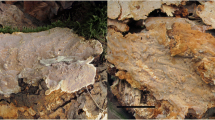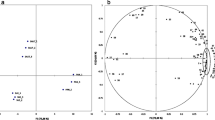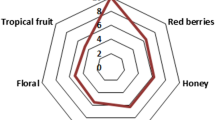Abstract
Headspace samples, steam distillates and dichloromethane extracts of the most well liked edible mushrooms (Agaricus campestris, Agaricus bisporus, Lepiota procera, Armillaria mellea, Boletus edulis and Cantharellus cibarius) were investigated by means of GC/FID, GC/FTIR/MS and a GC-sniffing technique. The aim of these analyses was the identification of constituents responsible for the typical mushroom odour of each species. To relate GC/Fouriertransform Infrarot-Detektor/MS (GC/FTIR/MS) data with olfactoric ones, the GC-sniffing technique was used. The results, especially of the headspace samples, showed that 1-octen-3-ol, a well-known mushroom aroma compound, is of basic importance for the top note of the investigated mushrooms. More than seventy constituents that additionally have an effect (qualitatively and quantitatively) on the odour impression of these species were identified. Among them especially C8-derivatives contribute in a significant way to the headspace odour of most of the samples. Carbonyls and esters (C4-C14) on the other hand play an important role (e.g. anisaldehyde inAgaricus samples) more in the steam distillate and extract samples.
Zusammenfassung
Kopfraum-Proben, Wasserdampfdestillate und Dichlormethanextrakte der beliebtesten Speisepilze Champignon (Agaricus campestris undAgaricus bisporus), Parasol (Riesenschirmpilz,Lepiota procera), Hallimasch (Armillaria mellea), Steinpilz (Herrenpilz,Boletus edulis) und Pfifferling (Eierschwamm,Cantharellus cibarius) wurden mittels GC/FID, GC/FTIR/MS und GC-Sniffing-Technik untersucht. Ziel dieser Untersuchungen war es, die für den typischen Duft der einzelnen Pilzarten verantwortlichen Inhaltsstoffe zu identifizieren. Um Daten aus GC/FTIR/MS-Messungen mit olfactorischen Daten direkt vergleichen zu können, wurde die GC-Sniffing-Technik verwendet. Die Ergebnisse, besonders solche von Kopfraumproben, zeigten, daß 1-Octen-3-o1, ein bekannter Pilzduftstoff, von grundlegender Bedeutung für die Kopfnote der untersuchten Pilze ist. Mehr als 70 Einzelkomponenten tragen qualitativ und quantitativ zum Gesamtgeruchseindruck der einzelnen Arten bei, wobei besonders C8-Derivate in signifikanter Weise den Duft der meisten Kopfraumproben beeinflussen. Carbonylverbindungen und Ester (C4-C14) dagegen spielen eine wesentliche Rolle (z. B. Anisaldehyd in Champignonproben) vor allem in den Wasserdampfdestillations- und Extraktproben.
Similar content being viewed by others
Literatur
Bicchi C, Joulain D (1990) Flav Fragr J 5:131
Brunke EJ, Hammerschmidt J, Schmaus G (1992) Dragoco Reports 39:3
Nikiforov A, Buchbauer G, Jirovetz L, Remberg B, Remberg G (1992) Z Naturforsch 47b:439
Dijkstra FY, Wiken TO (1976) Z Lebensm Unters Forsch 160:255
Georg V, Sharma SP, Tripathi AK, Abraham SP (1985) PAFAI J 7:27
Michael, Hennig, Kreisl (1983), Handbuch der Pilzfreunde, 5. Aufl. Fischer, Stuttgart
Jai Sik H, Myung Kon K, Jai Hong L, Hyung Moo K (1990) Hannguk Kyunhakhoechi 18:158. Chem Abstr (1991) 114:139950a
Kostelc JG, Hendry LB (1981) J Agr Food Chem 29:185
Picardi SM, Issenberg P (1973) J Agr Food Chem 21:959
Pyysalo H, Suihko M (1976) Lebensm Wiss Technol 9:371
Pyysalo H (1976) Acta Chem Scand B30:235
Stepanova EN, Tsapalova IE (1982) Izv Vyssh Uchebn Zaved Pischch Tekhnol 154. Chem Abstr (1983) 98:33403k
Thomas AF (1973) J Agr Food Chem 21:955
Tressl R, Bahri D, Engel KH (1982) J Agr Food Chem 30:89
Maarse H, Visscher (1989) Volatile compounds in food, 6th edn II:799 TNO. CIVO Food Analysis Institute, Zeist
Kreula M, Saarivirta M, Karanko SL (1978) Karstenia 18 [Suppl]:43. Chem Abstr (1980) 93:130884x
Phillip R (1982) Das Kosmosbuch der Pilze. Kosmos, Stuttgart
Schroedter R (1990) Flavour science and technology Wiley, New York, p 175
Wnuk S, Kinastowski S, Kaminski E (1983) Nahrung 27:479
Wurzenberger M, Grosch W (1983) Z Lebensm Unters Forsch 176:16
Maga JA (1981) J Agr Food Chem 29:1
Davsien's großes Pilzbuch (1983) Davsien, Hanau
Author information
Authors and Affiliations
Rights and permissions
About this article
Cite this article
Buchbauer, G., Jirovetz, L., Wasicky, M. et al. Zum Aroma von Speisepilzen. Z Lebensm Unters Forch 197, 429–433 (1993). https://doi.org/10.1007/BF01202612
Received:
Issue Date:
DOI: https://doi.org/10.1007/BF01202612




